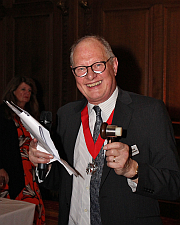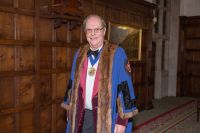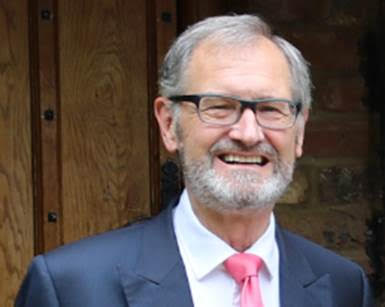
Well, it is not one of mine but I have walked in hills and noticed that the crest is always farther away than you think. But if you turn round the splendour of the view can take you by surprise. Difficult paths have disappeared as you have a more lofty view of the route you have travelled.
So it is with life. From time to time it is a pleasure to turn and savour the past. As this is the final edition of WCoMC news that Elizabeth is editing she is indulging this by allowing me a small reminiscence.
It is now more than 40 years since I started as a consultant. I came from a manufacturing background so was trained as a production consultant. In those days that meant work study and I still have the stopwatch I was given. Technology has of course moved on tremendously and so has the world of work. For example, I wrote my first book on consulting skills in 1987 and have recently completed revisions for the seventh edition. In the meantime I have had to replace references to postal correspondence with email, and the word ‘secretary’ with ‘PA’.
But it is the institutional landscape on which I’d like to focus.
My consulting career started with PA Consulting, which at the time was one of the larger consulting firms in the UK but even then had probably fewer than 100 consultants. We wondered then whether the accountancy firms’ management services units would ever become serious competitors.
PA sponsored membership of the Institute of Management Consultants – IMC. (Curiously I had previously been a member of another IMC – the Institute of Measurement and Control). A year’s experience entitled you to Associate Membership and after three years you could become a full Member, putting MIMC as a qualification after your name.
The IMC had been founded in 1962 by the Management Consultancies Association, itself founded in 1956. Senior members of the profession featured in the governance of both organisations and over the years PA provided a number of IMC Presidents. Initially the IMC got a lot of support from all the consulting firms, with the usual exception of the notable non-joiners like McKinsey. Association with the IMC lent endorsement to the emergent consulting practices of accounting firms, but as the strength of their brands grew they saw no need for this validation and so corporate support diminished.
My active involvement with the governance of the IMC started in the late 1980s and I served on the Council and Executive for many years. We sought to establish Chartered status for management consultants with the then President Michael Handscomb leading the efforts, but to no avail. He was therefore delighted to hear that this status has been achieved, and fitting that he heard it shortly before his death earlier this year.
One of the great challenges was growing membership. With any membership organisation there is a level of churn – you lose members each year and so have to run to stand still. We tried many ways of growing IMC membership – even retaining consultants to help us! – but membership levels remained stubbornly static. Funds were tight. We needed funds to attract members, but didn’t have the funds until we had more members. We therefore sought a breakthrough strategy which would turn the situation around, and a merger seemed to be the answer.
Over the years the IMC had flirted with the Institute of Business Advisers, but to no effect. We explored the possibility of remerging with the MCA – something that had been oft conjectured – but in the event there was little interest there. But there was interest from the Chartered Management Institute and this seemed to offer a lot of benefits to the IMC. There would be a shared back office with the consequent cost savings, and a lively programme of meetings around the country on management topics which would be of interest to IMC members, with the opportunity to network with potential clients – CMI members – at these.
I personally was attracted by a new way of running smaller institutes: a Unilever-type model. Unilever is not as well-known as its brands, but provides a common management infrastructure and support; so too, I could see, CMI could act as the back office for a number of small institutes which would appear as separate brands in the market place.
The merger took place on my watch as IMC President in 2004. There was resistance from a lot of IMC members, one commenting on the difference of size of the organisations that ‘if you go to bed with an elephant, however good your relationship there is a good chance the elephant will roll over and crush you!’
The Institute of Business Advisers also merged with CMI and shortly thereafter was merged with the IMC to form the Institute of Business Consulting (IBC).
In the UK – as indeed in most other countries – there is no need for a practising certificate to call yourself a consultant (indeed it was noticeable that at the time of the merger, there were as many CMI members who called themselves consultants as there were members of the IMC). The same is the case with many other professional institutes, who have cadres of members who are practising as consultants. In an attempt to engage them the IBC changed its name to the Institute of Consulting, which it remains to this day.
As one of the main actors in the loss of independence of the IMC, was it a good thing? It was a touch and go matter. In 2012 I was invited to speak at a dinner to celebrate the 50th anniversary of the IMC and told the following story:
‘All of us in consultancy know that there are meetings which are turning points – moments of truth. For us as a working party it came towards the end of 2003 when John Fairlie (an independent director of the IMC) convened a meeting at the Institute of Directors which Judith Wainwright (then President), Patrick Chapman  and I attended.
and I attended.
If anything, Judith was for the merger; Patrick was gently against it; and I was undecided, but was more aligned with Patrick than Judith. John declared that his objective for the meeting was to get me round to the idea of the merger. So Judith and Patrick went through the reasons for and against.
And then...
And then I went for a comfort break! A change in tempo and stretching your legs can clear the mind. To Patrick’s surprise when I returned I declared myself in favour of going ahead with the merger, and I have to confess to having a little lump in my throat as I realised what we were recommending: the loss of independence of an Institute into which all of us had invested so much time and effort.’
We can only guess what the outcome may have been had it not been for that comfort break!
But our own livery company is a product of the IMC. In 1992 the IMC held its annual dinner in Actuaries Hall with the then Lord Mayor as guest of honour. Afterwards I suggested that it might be worthwhile setting up a livery company for management consultants, only to find that a working party to do just that had been recently formed under the auspices of the MCA. Mike Jeans, a former President of the IMC, invited me to join the working party.
that had been recently formed under the auspices of the MCA. Mike Jeans, a former President of the IMC, invited me to join the working party.
 Already I knew two of the members of that working party – and David Miller and George Cox – as although they were currently involved in the MCA, they had previously served on the IMC Council.
Already I knew two of the members of that working party – and David Miller and George Cox – as although they were currently involved in the MCA, they had previously served on the IMC Council.
We decided to launch the idea of a livery company with a dinner at Painter Stainers hall on 30 September 1993. We invited all those we knew to attend and asked that they leave their business card in a salver as they left if they were interested in forming a livery company. We gathered 80 cards, which gave us the confidence to proceed.
Our Founder Master, the late David Miller, served for two years and I took over from him serving 1995 – 96. We started as a Guild, which meant that we were not part of the Civic City and so the time required as Master was much less than and rather different from now.
Our first Clerk was Ian Green who helped enormously in positioning the Guild within the City, and clearing the way to becoming a Company and then a Company with Livery. Ian was Clerk of two other companies, however, and so found the workload too much; Doris Goodwin took over from him while I was Master.
Much of the work at that time was establishing the foundations and arrangements that are now taken for granted, but many of the issues remain the same – growing membership, encouraging attendance at events, ensuring a flow of individuals to take office.
And looking back up the hill?
It is encouraging to see the Company continuing to thrive from those early beginnings. My energies are now going into developing its latest venture – the Centre for Management Consulting Excellence. I hope that the same success will attend it over the coming years.
Calvert Markham